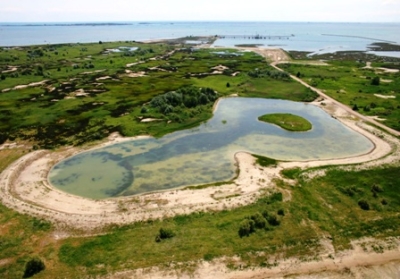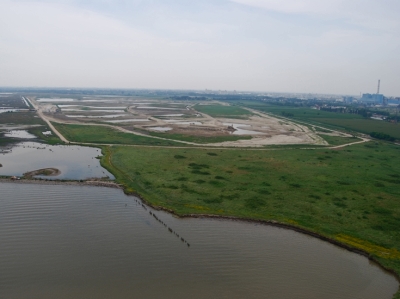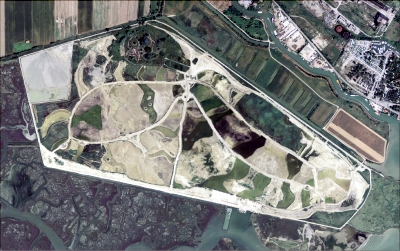PIF - the integrated and circular wastewater treatment system
The Fusina Integrated Project (PIF) is a great environmental policy challenge, which has been risen up to jointly with the State, the Region an the local authorities and has led to the drafting of a regional programming and planning tool known as the “2000 Steering Plan”. Remarkable engineering work, promoted by the Veneto Region, which employs roughly 200 million euros and will be completed within 2013. 50% of the project is financed by regional funds and the remaining 50% by means of a Project Financing operation.
There is a dual objective: to protect the Venice lagoon by drastically limiting effluents though purified and spare drinking water by extensively recycling the water used for industrial purposes.
The project is based on simple concepts: to use water twice thus reducing total flows; to concentrate and treat waters in one single place by reaching high standards; to bypass the lagoon with a piping system and leak them into the open sea by complying with even more restrictive limits than those imposed by the European Union.

PIF entails the evolution of the current Fusina purification plant in a multi-functional platform, by adapting the biological processes and introducing primary chemical-physical treatments followed by the phytopurification of the outlet flows. Into PIF are treated all the industrial waste and the polluted ground water of Porto Marghera stemming from the systems designed to make the site of Porto Marghera safe, the civil effluents and the rainwater of Mestre, Marghera and the Mirese basin, with a capacity of almost 135,000 cubic metres per day.
Subsequently, the purified and regenerated water up to 100,000 cubic metres per day is provided for industrial uses to the cooling plants, thus allowing to earmark the water flowing from the Veneto springs for drinking purposes.
In particular, the current intake of the industrial waterworks from the Sile river is replaced. Now the regional planning authorities have decided to use the water of this river - which has an excellent drinking quality - also to feed the great system interconnecting the central Veneto region waterworks, especially towards the most disadvantaged areas in the southern Veneto region.
In this way better waterworks services will be ensured, as well as an appropriate management of the water integrated cycle, with great advantages for the protection and saving of environmental resources.
The Fusina Integrated Project is composed of:
- the purification system;
- the feeding lines for the treatment of civil, industrial and ground waste waters;
- the distribution line for water reuse;
- the piping system for residual discharging into the sea (a 20 km long great pipe with a 160 cm diameter), that avoids the direct discharging into the Lagoon.
The terminal part of the system is a phytopurification basin located on “Cassa di Colmata A”, a 150 hectares area south of Fusina, which in the 1960s was used to store the materials coming from the excavation of primary navigation canals in the lagoon. It must be underlined that this artificial area, turned into a naturalistic area, will be a link between the mainland and the lagoon, as well as a green area which will be well-integrated with the green areas of the Venice hinterland.
Hence the Fusina Integrated Project meets the people’s demands of having a green area available to them - a real oasis for recreational, sport and environmental education purposes.
Waterproof barriers are being built along the port canals in order to prevent the erosion of Porto Marghera polluted soils and the flowing of polluted waters into the lagoon.
Moreover, a 20 km long pipe with a 160 cm diameter has been laying for the final discharging into the sea of the waters exceeding the reuse capacity, downstream the corrective post-treatments envisaged at the Fusina purification plant. The delivery point is located at about 10 km off the coast at a depth of roughly 20 metres.
This great hydro-logistical and engineering system for protecting water resources has been conceived as an "open reuse cycle", which reduces the final discharge volume bymore than 50%. The Fusina Integrated Project also envisages the implementation of a series of interventions linked by the common goal of the environmental and socioeconomic rehabilitation of the Porto Marghera wide area. These are “integrated” interventions arising from the need to clean and purify Venice canals. In fact, the dredging of the port canals had been postponed for many years, especially due to the difficulties incurred in getting rid of polluted sediments and the high disposal costs, which had slowed down the process to make Porto Marghera safe.
However , the appointment to the special Commissioner for the socio-economic and environmental emergency related to the port canals of the Venice lagoon - who took actions by relinquishing the exceptions he could have made in full compliance with rules - allowed to break the stalemate.
This was possible thanks to a “Program Agreement” which involved twenty public institutional bodies and private companies and was supported by the people living in the area, in the framework of this great project for environmental recovery complying with the Agenda 21 criteria.

For three months people were involved in thematic debates – sometimes lively and heated, but always positive and constructive. Besides the measures strictly necessary to dispose of sediments, the following measures have been taken:
- enlargement of the Tresse island to confine most sediments of the primary navigation canals (poor quality sediments);
- filling of a port area (the so-called "Sali" pier) to store the non-dangerous sediments under safe conditions;
- rehabilitation of the Vallone-Moranzani area, which has become a safe container for the most polluted sediments and soils – though inertized.
The parties signatories to the Agreement have decided the following compensatory interventions:
- the laying underground of the long distance power lines in the Vallone Moranzani area, thus reducing the electromagnetic and landscape impact;
- the revision of the entire road system, by separating the urban vehicle flows from the commercial-industrial ones and the creation of a network of cycling tracks;
- the rehabilitation of the hydraulic system both in urban and rural areas to prevent floods, which are currently too frequent;
- the delocalization of an oil deposit industrial plant, which is too close to residential areas;
- the creation of 200 hectares of parks on the reclaimed or rehabilitated areas.
